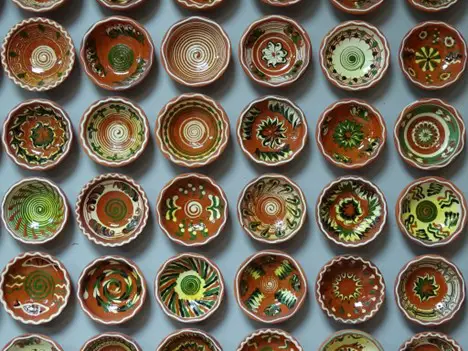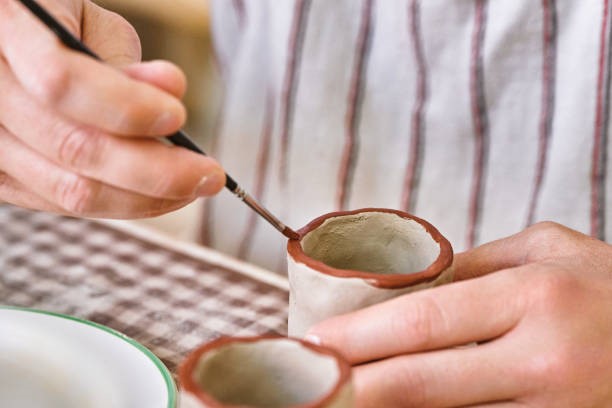As a pottery artist, it is often easy for beginners to get confused between clay and ceramics. Although clay is identified as a ceramic, these terms are used separately because clay is available in abundance while ceramic isn’t. While we do know the best clay crafting techniques, it is also important to learn some common ceramic techniques to further your journey as a pottery artist. So, what are these must-know ceramic techniques? Let us learn more about them!
But before we get to these techniques, let us understand how clay and ceramics are two different things.
Clay vs. Ceramic: How Are They Different?
The primary difference between ceramic and clay is very basic. While clay comprises moistened minerals like crystalline silica and aluminum silicates, ceramic comprises metal oxides like silica, zirconium, and silica carbide.
Let us decode some of the key differences between ceramic and clay:
| Ceramic | Clay |
| Ceramic Is Comprised Of Nonmetallic And Inorganic Materials That Harden When Exposed To High Temperatures | Clay Is Made Up Of Natural Soil Materials That Also Consist Of Clay Minerals |
| Comprised Of Metal Oxides Like Silica Carbide, Silica Oxide, Or Zirconium Oxide | Comprised Of Crystalline Silica And Aluminum Silicates |
| Ceramic Kilns Work Best For Handling High-Fire Clay | Clay Kilns Work Best For Handling Low-Fire Clay |
| Expensive | Cheap |
Now that you know the difference between clay and ceramic, let us decode the techniques used with ceramic.
What Are Some Popular Ceramic Techniques?
While we are well aware of common ceramic techniques like slip-casting, hand-building, and wheel-throwing, there are several other popular ceramic techniques that deserve equal recognition. So, what are they? Let us learn more about these techniques that can upscale your ceramic pottery escapades.
1. Sgraffito:
Sgraffito in the ceramic world means the delicate art of scratching the pottery surface. In this technique, pottery artists scratch through the glaze or slip layer to reveal portions of the clay underneath. Next, Sgraffito artists apply several layers of glaze or slip, depending on the final design, and let it dry. Once it has dried, a sharp tool is used, like a pottery needle, to carve out designs and textures on the surface. A great pottery carving tool set artists can try is the S&E Pottery & Clay Sculpting Tool Set with smooth wooden handles.

This technique can be used to create contrasting textures and designs. Moreover, it can be carved at any stage of the pottery-making process. Sgraffito can also be combined with decorative techniques such as acrylic painting to create a layered design.
2. Mishima:
Mishima is a ceramic technique that works in a way similar to sgraffito but is just the opposite. Confused? Well, in sgraffito, you carve into the glaze or slip. However, in the Mishima technique, pottery artists carve on the ceramic ware itself and then fill it with contrast-colored glaze or slip. The excess is then wiped away with the help of a dry cloth or sponge.
In order to create these designs on ceramic, pottery artists first apply glaze or slip on the surface. Then, after it has dried out completely, the artist uses things like a knife or needle to carve out the desired design. Once it is done, the design is filled with colored glaze or slip. Mishima is a delicate and interesting technique known for adding depth and subtle effects to the ceramic piece.
3. Nerikomi:
If you love traditional Japanese ceramic techniques, you will love Nerikomi. This technique involves layering several colored clay pieces together. The resulting piece is a culmination of intricate designs and patterns. Nerikomi resonates with the marbling technique in paper-making.
Creating ceramic pottery ware with Nerikomi involves mixing several clay variants of different textures, colors, or consistencies. The artist stacks layers of clay one over another and then compresses them. This creates one solid clay block that is then sliced to reveal thin sections of layered patterns.
Potters can use these layered slices to create ceramic pieces like plates, vases, cups, and bowls. Then, depending on one’s personal preference, the final piece can be glazed or left as it is to let the natural beauty of the layered clay pop.
4. Obvara Firing:
Pottery artists looking for a one-of-a-kind technique can experiment with obvara firing for ceramics. It is a traditional Eastern European ceramic firing technique. Obvara firing involves the use of a mixture prepared with water, yeast, and flour. This creates a uniquely textured surface while adding a beautiful color after the firing is done.
For obvara firing, the ceramic piece is first heated to a very high temperature. When fired in a kiln, this temperature typically ranges between 900 and 1000 degrees Celsius. Then, while the ceramic ware is still piping hot, it is gently removed from the kiln and immediately dipped into the mixture. This induces a chemical reaction that quickly reduces the carbon dioxide and oxygen levels on the pottery piece’s surface. The final result is a distinctive brown, black, and rust-colored surface on the ceramic.
5. Terra Sigillata:
Another great ceramic technique is the terra sigillata that pottery artists use to create a shiny surface post-firing. In the process of making ceramic ware with terra sigillata, fine clay particles are suspended water. This is then allowed to settle for a good time, creating a dense liquid with a high proportion of solid clay particles.
The mixture is similar to slip with a smooth texture that can be applied on the surface of the ceramic piece before firing in a kiln. Once fired, the slip creates a polished finish that looks similar to satin.
Conclusion
When trying out these ceramic techniques, keep in mind that safety is of the utmost importance. You might not get it right on the first try, but the key is practice and precision. Start with the one that feels the easiest to you and work your way up toward the complicated ones. Keep in mind the final result can vary depending on your skills and experience. Moreover, pottery is like cooking. Even with the same ingredients and crafting techniques, the results can differ for various ceramic artists. So, if your artwork is even close enough, it’s a big milestone for you as an artist!








